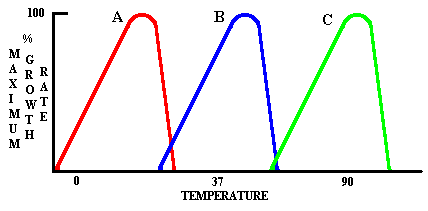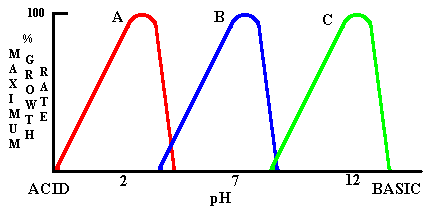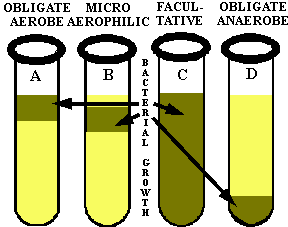

![]()
The Biologist, Stephen J. Gould, makes a compelling
argument in his book, "Full House" , that
we live in the AGE of the
BACTERIA. He feels that it has always been and
always will be thus. If he is correct, then it behooves us to learn how this
came about and how the bacteria maintain their dominance on Earth. He supports
this conclusion by the fact that bacteria flourish in prodigious numbers in
almost every environment on Earth where free-water is available, including the
deepest parts of the ocean, at temperatures of <0oC to
>120oC, in acid and alkaline waters, in the presence of toxic
substances, and even bathed in the radiation's emanating from atomic reactors.
Bacteria metabolize everything from gasoline, antibiotics and plastics to
elemental sulfur and manganese. They even live deep in the bowels of the earth.
![]() Recently a bacterium, Shewanella
putrefaciens, has been found that uses manganese rather than
oxygen as an electron acceptor; that is, it is "a manganese
breather".
Recently a bacterium, Shewanella
putrefaciens, has been found that uses manganese rather than
oxygen as an electron acceptor; that is, it is "a manganese
breather".
A major advantage the bacteria have is that the vast majority of them are capable of rapid growth rates. Many bacteria can divide, that is, produce a NEW GENERATION, every 20 to 30 minutes under optimal environmental and nutrient conditions. Whereas, the human generation time is ~25 years. All forms of life are capable of what is called exponential or logarithmic growth in which the numbers of a species double each generation (e.g. 1, 2, 4, 8, 16, 32, 64 etc.). When this data is plotted as the numbers of a species vs. time it produces a classical growth curve that looks like this:
In the case of bacteria the timeline could, in theory, start with a single cell and end 24 hours later (assuming no death) with a bacterial-mass near the weight of the earth. It is interesting to note that the human population growth curve looks exactly the same; the population reached 6 billion people this month and it may double again by the time you are my current age. Another way to look at this is that a single bacterium can produce, in about 12 hours, ~5 billion offspring in two milliliters of medium; something it has taken the human 3.5 billion years to do. Unhindered growth, of course, requires unlimited nutrient supply and an unchanging environment, however, in real life this is impossible. At some point, usually sooner rather than later, something becomes unfavorable. Usually a critical nutrient becomes limiting. For example, the supply of the energy source may run out, or a trace element may become limiting or a predator may appear or waste will become toxic or a disease will take hold; any of these inhibit and eventually stop growth. The norm in nature is for a catastrophic crash to occur following a period of rapid, vigorous reproduction. In such cases the population usually undergoes a rapid die-off and the organism may even become extinct in a local region. The cycles of population increase, followed by a rapid population decline are typical of the natural world. One can not help but wonder if such a fate may await the human population.
A major advantage of the rapid reproduction time, and one that makes the bacteria so successful, is that they are able to evolve so much faster. That is, as you will see in Chapters 6 and 8, evolution occurs through mutations that produce variations in the offspring of organisms. Then the environment determines which, if any mutations are advantageous. Those organisms with the advantageous mutations tend to survive and live on. Because of their faster generation times bacteria can test billions of mutations for survival while a single human may take 25 or more years to test a given mutation. Watch bacteria grow.
In this Chapter you will see what bacteria require in order to grow. It should be no surprise to you to learn that, in general, they have the same needs we, and every other form of life, require (however, their biochemistry can get rather kinky).
All life has the same BASIC NUTRITIONAL REQUIREMENTS which include:
![]() A SOURCE OF ENERGY. This may be light (the sun or lamps)
or inorganic substances like sulfur, carbon monoxide or ammonia, or preformed
organic matter like sugar, protein, fats etc. Without energy life can not exist
and quickly dies or becomes inactive.
A SOURCE OF ENERGY. This may be light (the sun or lamps)
or inorganic substances like sulfur, carbon monoxide or ammonia, or preformed
organic matter like sugar, protein, fats etc. Without energy life can not exist
and quickly dies or becomes inactive.
![]() A SOURCE OF NITROGEN. This may be nitrogen gas, ammonia,
nitrate/nitrite, or a nitrogenous organic compound like protein or nucleic acid.
A SOURCE OF NITROGEN. This may be nitrogen gas, ammonia,
nitrate/nitrite, or a nitrogenous organic compound like protein or nucleic acid.
![]() A SOURCE OF CARBON. This can be carbon dioxide or
monoxide, methane, carbon monoxide, or complex organic material
A SOURCE OF CARBON. This can be carbon dioxide or
monoxide, methane, carbon monoxide, or complex organic material
![]() A SOURCE OF OXYGEN. All cells use oxygen in a bound form
and many require gaseous oxygen (air), but oxygen is lethal to many microbes.
A SOURCE OF OXYGEN. All cells use oxygen in a bound form
and many require gaseous oxygen (air), but oxygen is lethal to many microbes.
![]() A SOURCE OF PHOSPHOROUS, SULFUR,
MAGNESIUM, POTASSIUM & SODIUM.
A SOURCE OF PHOSPHOROUS, SULFUR,
MAGNESIUM, POTASSIUM & SODIUM.
![]() A SOURCE OF CALCIUM. Most cells require calcium in
significant quantities, but some seem to only need it in trace amounts.
A SOURCE OF CALCIUM. Most cells require calcium in
significant quantities, but some seem to only need it in trace amounts.
![]() A SOURCE OF WATER. All life requires liquid water in order to grow and reproduce; which is
why the Mars Mission is so interested in water on Mars. Some resting stages of
cells, like #bacterial
spores, can exist for long periods without free water, but they do not grow
or metabolize.
A SOURCE OF WATER. All life requires liquid water in order to grow and reproduce; which is
why the Mars Mission is so interested in water on Mars. Some resting stages of
cells, like #bacterial
spores, can exist for long periods without free water, but they do not grow
or metabolize.
![]() A SOURCE OF MINERALS LIKE IRON,
ZINC, COBALT ETC. These are called TRACE metals that are
required by some enzymes to function.
A SOURCE OF MINERALS LIKE IRON,
ZINC, COBALT ETC. These are called TRACE metals that are
required by some enzymes to function.
The sources of these various requirements DEFINES AN ORGANISM, so a description of every organism should include this information. Many bacteria can synthesize every complex molecule they need from the BASIC MINERALS, but others, said to be FASTIDIOUS, require PREFORMED organic molecules like vitamins, amino acids, nucleic acids, carbohydrates; humans are fastidious. In general bacterial pathogens need more PREFORMED ORGANIC MOLECULES than do nonpathogens, but that is not always true. For example some bacteria that are found in milk hardly make any of their own basic organic molecules, that is they let the cow (or more to the point the #microbes that live in the cow's gut) make these things for them. A simple rule of thumb is "if humans can use something for food, many microbes will also love it". The reverse is not always as true as microbes can "digest" some very strange substances including cellulose, sulfur, some plastics, turkey feathers and asphalt, to name just a few.
![]()
![]()
Bacteria live in the most diverse range of environments of any forms of life. There are bacteria that live in salt water below freezing in melted ice pockets in the Antarctic, in saturated salt solutions, in boiling hot springs, in acid waters at pH <2.0, around the core of atomic reactors, in the fuel tanks of airplanes, at the bottom of the ocean at >110oC (Click here to view a video of life around volcanic vents), and hundreds of feet below the surface of the ground. A basic principle of microbial growth is that every microbe has a PREFERRED ENVIRONMENT and it is a challenge to the investigator to tease out the unique set of conditions, called the OPTIMAL GROWTH CONDITIONS that suits each microbe best. It is estimated that we currently are able to cultivate only a few percent of the 100,000s of bacterial species. The reason for this is evolution. Every microbe has evolved (over 3.5 billion years) to fit into a UNIQUE ENVIRONMENT which gives it MAXIMUM SURVIVAL POTENTIAL. Everyone of a bacteria's 2 to 4,000 genes has been designed for the purpose of maximum survival in a unique environment, called its NICHE.


Figure 2. Generalized graphs defining the optimum growth conditions of bacteria. These cartoons illustrate the optimum conditions of growth of various bacteria with regards to temperature and pH. Microbes (left A) that require cold temperatures are called PSYCHROPHILES and you've all seen them lurking in the dark corners of your refrigerator. Those that grow best between about 25oC and 45oC (left B) are MESOPHILES, while those that grow optimally between 50-80oC are called THERMOPHILES (left C) and those that grow best above 80-110oC are called EXTREME THERMOPHILES. Similarly, microbes have different optimum pH requirements. The microbes that can grow in acid waters and are appropriately called ACIDOPHILES (right A). As you might guess most microbes prefer a pH near neutrality and thus are called NEUTROPHILES (right B). A few microbes can grow in very alkaline waters such as those found in the alkaline lakes of central Oregon and Washington; these are called ALKALINOPHILES (right C).
The curves in Fig. 2 show minimum, optimum and maximum growth conditions for the assigned variable. Similar curves can be plotted for every environmental conditions that affects a microbe's existence.
|
|
The most common environmental conditions that a microbiologist considers are temperature, pH, oxygen, light, salt/sugar concentration and special nutrients. Each bacteria has an optimum range of these conditions within which it grows at a maximum rate. In some cases this may be a fairly broad range such as bacteria that can grow maximally over a five to 10 degree temperature span. In other cases it may be quite narrow; the temperature allowing growth spanning only a few degrees. To determine the optimum environmental conditions a scientist considers the environment where the bacterium is NORMALLY FOUND. However, this can be deceptive since even a 1 cm cube of soil may contain 100s of unique MICROENVIRONMENTS. Never-the-less an investigator trying to cultivate a new bacterium will test the growth of a bacteria in media that varies over a range of temperatures, pH, oxygen and salt concentrations. If that fails to support bacterial growth more exotic environmental variations are tried. At least one acidophile can grow at pH 0.7

Figure 4. The relative growth
requirements for oxygen. The medium without bacteria is yellow, while bacterial growth is
indicated by the green color. For
example, obligate aerobes and anaerobes, grow respectively only at the top
(A) and bottom (D) of a tube of liquid medium. Obligate aerobes often form a
film (scum) or pellicle, that floats on the top of the liquid. Facultative aerobes have the
best of both worlds, as they are able to grow under both aerobic and anaerobic
conditions (C). Microaerophilic bacteria require a little bit of oxygen, but too
much is toxic (B).
![]()
![]() CRITICAL THINKING QUESTIONS: Why does it make sense from a nutritional
standpoint that most pathogens are nutritionally fastidious?
CRITICAL THINKING QUESTIONS: Why does it make sense from a nutritional
standpoint that most pathogens are nutritionally fastidious?
If a bacteria is observed to be present in large numbers in the human gut, what would you guess are its likely basic environmental requirements?
![]()